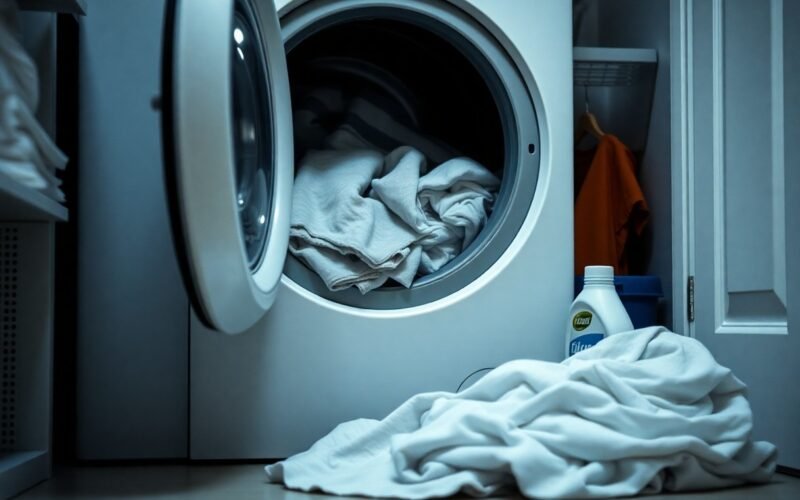It’s frustrating to pull your clothes from the washer only to find they’re still dirty or stained. You may be wondering why this happens despite following all the washing instructions. Understanding common pitfalls in laundry practices can help you identify the reason behind your laundry woes. Factors such as overloading the machine, using the wrong detergent, or not selecting the appropriate cycle can all contribute to a less-than-satisfactory clean. In this post, we’ll explore the reasons your clothes might still be dirty after washing and how you can ensure a fresher result.
Key Takeaways:
- Overloading the washing machine can prevent clothes from getting clean, as it limits agitation and water circulation needed for effective washing.
- Using the wrong detergent type or insufficient amounts can result in residues and odors, emphasizing the importance of following detergent guidelines based on load size and soil level.
- Not treating stains before washing may leave them unremoved, as some stains require pre-treatment to effectively break down and lift them from fabrics during the wash cycle.
The Role of Detergents: Are You Using the Right One?
The effectiveness of your washing routine largely hinges on the detergent you’re using. Not all detergents are formulated the same; some are optimized for specific types of stains or fabrics. If you’re not using a detergent that targets the stains present on your clothes, you might as well be washing them with water. Consider reviewing Reasons Your Clothes are Still Dirty and Wet to find a detergent that suits your laundry needs better.
The Chemistry of Cleaning Agents
The cleaning power of detergents comes from their chemical composition. Detergents contain surfactants that reduce surface tension, allowing water to penetrate fabric fibers and lift dirt more effectively. When choosing a detergent, look for one that contains enzymes, as these biological cleaners break down protein-based stains from food and sweat, making them more manageable.
Impact of Water Hardness on Detergent Effectiveness
Water hardness plays a significant role in how well your detergent performs. Hard water contains high levels of calcium and magnesium ions, which can bind with the surfactants in your detergent, reducing their cleaning ability. If you live in an area with hard water, consider using a water softener or a detergent formulated for hard water to enhance cleanliness.
Hard water can dramatically diminish the effectiveness of even the best detergents. In fact, studies show that up to 80% of Americans live in areas with hard water, which means their laundry could be suffering as a result. You may notice that clothes feel stiff or appear dingy, as the minerals can leave deposits on fabrics. Switching to a detergent that counteracts these effects can make a noticeable difference in the cleanliness of your laundry.
Washing Machine Maintenance: Is Your Machine Working Properly?
Your washing machine’s functionality directly impacts wash performance, so ensuring it operates correctly is necessary. Regularly checking the condition of components such as the drum, seals, and hoses can help identify issues before they escalate. If you notice any unusual noises during operation or inconsistent washing results, it may be time to troubleshoot or seek professional help. The efficiency of your machine hinges on both its mechanical integrity and the cleanliness of its various elements.
Common Mechanical Issues Affecting Wash Performance
Importance of Regular Cleaning and Maintenance
Over time, lint, detergent residue, and grime can build up within your washing machine, significantly influencing its wash performance. Neglecting this regular maintenance leads to reduced efficiency and potentially costly repairs down the line. Cleaning the drum and filters regularly not only improves wash quality but also prolongs the life of your machine. Additionally, descaling and wiping down seals can prevent mold and unpleasant smells, creating a better washing environment. By dedicating time to maintenance, you enhance your laundry experience while protecting your investment in the appliance.
The Temperature Factor: Are You Washing Clothes Cold When You Shouldn’t?
Your laundry routine may be suffering from the indiscriminate use of cold water. While cold washing is often energy-efficient, certain stains and soils may require higher temperatures for effective removal. When you choose a lower temperature setting, you might not achieve the clean you expect, particularly with grease, oil, or protein-based stains, such as blood or sweat.
Effect of Water Temperature on Stains and Soil Removal
| Water Temperature | Stains Removed |
|---|---|
| Cold (≤ 60°F) | Light soil, colors |
| Warm (60-80°F) | Everyday dirt, some grease |
| Hot (≥ 130°F) | Heavy soil, grease, oils |
| Boiling (≥ 212°F) | Sanitizing, tough stains |
| Recommended for specific fabrics | See below |
Recommendations for Different Fabric Types
Choosing the right water temperature based on fabric type enhances cleaning performance. For example, cotton and linen tolerate hot water, effectively dissolving dirt and oils. Synthetics, which can be damaged by heat, fare better in warm washes to avoid shrinking or fading. Delicates, like silk and lace, should be washed cold to maintain their integrity and appearance.
Recommendations for Different Fabric Types
| Fabric Type | Recommended Temperature |
|---|---|
| Cotton | Hot |
| Colorfast Synthetics | Warm |
| Delicates (e.g., silk) | Cold |
| Wool | Cold or lukewarm |
| Linen | Hot |
- Cotton performs best in hot settings for bright whites or heavily soiled items.
- Synthetics such as polyester should generally stick to warm washes to preserve fibers.
- Delicates need careful treatment; cold washes prevent damage.
- Wool often requires low temperatures to retain its elasticity.
- For linen, high heat removes residue effectively yet keeps fabric crisp.
Environmental considerations and laundry efficiency often lead to choosing cold washes. Perceiving benefits doesn’t negate that some serious stains demand the warmth of hot water. The right temperature not only affects stain removal but also fabric longevity, so knowing your garments is important.
Recommendations for Different Fabric Types
| Fabric Type | Recommended Temperature |
|---|---|
| Cotton | Hot (≥ 130°F) |
| Colorfast Synthetics | Warm (60-80°F) |
| Delicates (e.g., silk) | Cold (≤ 60°F) |
| Wool | Cold or lukewarm |
| Linen | Hot (≥ 130°F) |
The Stain-First Approach: Why Pre-Treating is Key
Pre-treating your clothes before washing significantly increases the chances of removing stubborn stains. By applying a suitable stain remover or detergent directly onto the stained area, you allow the solution to penetrate the fabric fibers. This initial step is important for breaking down the stain’s structure, making it easier for your washing machine to wash it away effectively. For more insights on why your laundry isn’t coming out clean, check out this thread on Why is the washing machine not cleaning my clothes?
Types of Stains and Their Treatments
Understanding the type of stain you are dealing with ensures that you choose the right treatment for effective removal.
| Stain Type | Recommended Treatment |
| Grease | Dish soap or a stain remover with enzymes |
| Blood | Cold water and hydrogen peroxide |
| Ink | Rubbing alcohol or hand sanitizer |
| Red Wine | Salt followed by cold water rinse |
- Always act quickly on stains for the best results.
- Test any treatment on an inconspicuous area first.
- Use gentle blotting rather than rubbing to avoid spreading.
- Follow up with a wash after pre-treatment.
- Thou must choose the correct product for specific stain types.
Best Practices for Pre-Treating Clothes
Thoroughly treating stains boosts laundry success rates significantly. When you pre-treat, apply the stain remover directly and let it sit for 5 to 10 minutes, allowing the formula to penetrate effectively. Use a soft brush or cloth to lightly work the product into the fabric without damaging it. After treatment, avoid letting the stained item dry, as this can set the stain permanently. Opt for washing after pre-treatment with the appropriate settings based on fabric type and water temperature.
Overloading the Washer: A Common Pitfall
Overloading your washing machine leads to poor cleaning results and can even damage your appliance. When you jam too many clothes into the washer, there’s insufficient space for them to move freely during the cycle. This restricts the water and detergent from effectively penetrating and agitating the fabric, ultimately leaving dirt and stains behind. The number of clothes that can be washed in one load depends on the washer’s capacity, so be mindful not to surpass it.
The Importance of Load Size and Distribution
Choosing the right load size is imperative for achieving consistently clean laundry. An overloaded washer can lead not only to dirty clothes but also to unbalanced loads that prevent proper spinning. When the laundry is unevenly distributed, the washer can shake excessively and even damage its internal components, resulting in costly repairs.
Strategies for Optimal Washing Loads
To maximize the efficiency of your washing machine, load it appropriately by keeping a few strategies in mind. First, use the manufacturer’s guidelines to determine the maximum weight your washer can handle. Secondly, mix heavy and light items to promote balance within the load. Finally, ensure not to overcrowd the drum; a general rule of thumb is to fill it about three-quarters full for optimal performance.
Breaking down your loads can significantly improve the outcome of your laundry cycles. For instance, instead of washing a full basket of mixed fabrics, separate them into smaller, categorized groups like towels, delicates, and everyday wear. Each type typically requires different washing conditions, making it easier to remove dirt and odors. Aim for a balanced load that leaves some room for movement; this ensures that every item receives ample water and detergent exposure, enhancing the cleaning process.
Conclusion
Hence, if your clothes are still dirty after washing, it’s vital to assess various factors such as detergent effectiveness, water temperature, and machine maintenance. Understanding your washing machine’s settings and ensuring proper load size can significantly enhance washing performance. If you’re still encountering issues, consider exploring solutions for common washing machine problems, like What Can You Do When Your Washing Machine Leaves Stains?. Taking these steps can lead to cleaner, fresher laundry every time.
Q: Why do my clothes still have stains after washing?
A: There are several reasons why stains may remain on your clothes after washing. First, not all stains are the same; some may require pre-treatment with stain removers. Second, you may not be using the right water temperature for the fabrics or types of stains—cold water, for example, is effective for some stains but may struggle with grease. Finally, an overcrowded washing machine can prevent clothes from moving freely, resulting in ineffective cleaning. Always check care labels and consider separating heavily soiled items from lightly soiled ones for better cleaning results.
Q: Am I using enough detergent for my laundry?
A: Insufficient detergent can contribute to clothes not getting clean. If your load is particularly large, you may need to increase the amount of detergent. On the other hand, using too much detergent can lead to residue buildup on fabrics, which can also leave clothes looking dirty. It’s important to follow the instructions on the detergent packaging and adjust based on the load size, soil level, and water hardness. If your clothes still feel soapy after washing, it may indicate that you’re using too much detergent, which can also hinder the cleaning process.
Q: Is the washing machine itself causing the problem?
A: Yes, the condition of your washing machine can significantly impact how clean your clothes come out. If your machine is not regularly cleaned, lint, dirt, and detergent residue can build up, transferring back onto your clothes during the wash cycle. It’s advisable to run a cleaning cycle or use washing machine cleaners periodically to keep it in good condition. Additionally, ensure that your washing machine is well-maintained, with hoses and filters regularly checked for blockages that could hinder proper cleaning.




